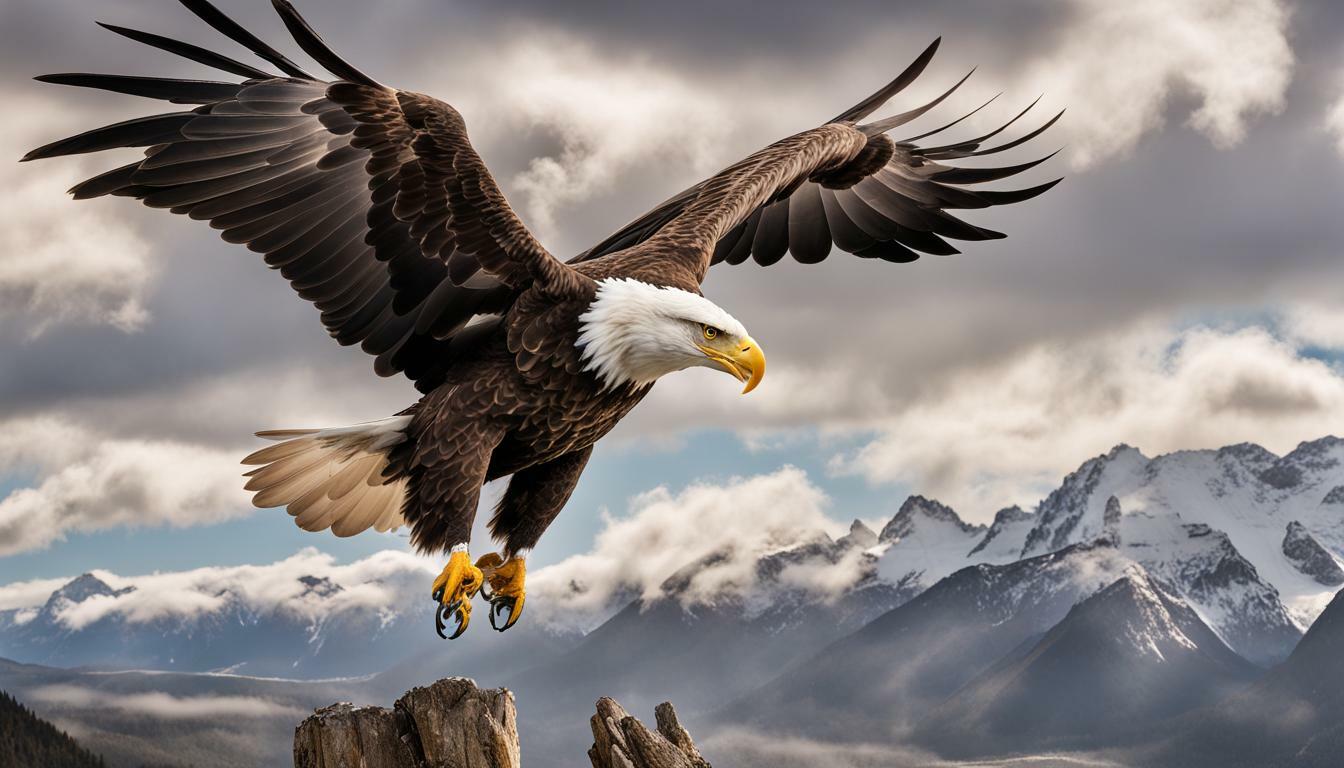When you think of bald eagles, one of the first images that might come to mind is a majestic bird soaring through the sky. These birds of prey are known for their impressive flight capabilities, including their ability to reach impressive heights during their journeys.
In this section, we will explore the heights that bald eagles can reach during flight, delving into the impressive wingspan and flight adaptations that enable them to soar to great heights. We’ll also discuss the factors that influence their flying altitudes and their adaptability to varying heights.
Key Takeaways:
- Bald eagles are capable of reaching remarkable heights during flight.
- Their impressive wingspan and flight adaptations play a significant role in determining their flying altitude.
- Factors such as weather conditions and prey availability can influence their flying altitudes.
- Bald eagles possess remarkable adaptability when navigating different altitudes.
The Majestic Bald Eagle: An Overview
Before exploring the heights that bald eagles can reach during flight, let’s take a moment to appreciate the majestic nature of these remarkable creatures.
Bald eagles are iconic birds of prey, known for their impressive wingspan, sharp talons, and piercing gaze. They are found throughout North America, typically near large bodies of water where they can hunt for fish and water birds.
These birds are built for flight, with wings designed for soaring and gliding for extended periods without expending much energy. Their incredible flying capabilities are a defining characteristic of the species.
The Bald Eagle’s Flight Capabilities
Bald eagles are renowned for their flying abilities, and for good reason. Their wingspan can reach up to 7 feet, allowing them to cover great distances with ease. They can soar at altitudes of up to 10,000 feet, though they typically fly at lower altitudes.
Bald eagles are also incredibly adaptable when it comes to their flight patterns, utilizing various wind patterns and thermal updrafts to conserve energy and stay aloft for extended periods. They can even fly in adverse weather conditions, including rain, snow, and strong winds.
Despite their impressive size and weight, bald eagles are also skilled at acrobatic maneuvers, such as aerial dives and swoops, making them formidable hunters.
Overall, their flight capabilities are an essential component of their survival and a defining feature of this incredible species.
Wingspan and Flight Adaptations
Bald eagles possess a wingspan of up to 7 feet, which plays a vital role in determining their flying altitude. With such a wide wingspan, they can generate more lift and stay airborne for more extended periods.
Moreover, bald eagles have sturdy primary feathers that provide them with exceptional lift and control during flight. They can adjust their wings to take advantage of thermal updrafts and wind currents, allowing them to soar to great heights without flapping their wings tirelessly.
Their keen eyesight, which is five to six times sharper than a human’s, enables them to spot prey from high altitudes when scanning the landscape below. They can also lock their wings and make rapid, controlled dives while hunting, ensuring they capture their prey with precision.
Soaring to Great Heights: Bald Eagle Flight Patterns
One of the most remarkable features of bald eagles is their ability to soar to great heights. To achieve this, they utilize thermal updrafts and wind patterns found in their natural habitats. These updrafts provide the necessary lift for bald eagles to gain altitude without expending too much energy. Once they reach a certain height, they can soar for hours without having to flap their wings.
Thermal updrafts are created when the sun heats the ground, causing warm air to rise. As the warm air rises, it creates a column of air that eagles can use to gain altitude. Bald eagles are also skilled at using wind patterns to their advantage. They can use tailwinds to increase their speed and headwinds to slow down or hover in place.
Soaring and Hunting
Bald eagles typically soar when searching for prey or during long-distance migrations. Soaring allows them to cover vast distances while minimizing their energy consumption. When hunting, they combine their soaring abilities with their exceptional eyesight to spot prey from high altitudes. Once they locate a potential target, they will dive toward it at speeds reaching up to 100 miles per hour.
Bald eagles are also known for their impressive hunting tactics, capable of snatching prey from both land and water. They can use their powerful talons to grab fish from the water or take small mammals, such as rabbits and squirrels, from the ground.
Their hunting prowess, combined with their exceptional flying abilities, makes bald eagles a truly impressive sight in the skies.
Exceptional Altitudes: Maximum Flying Heights
When it comes to flying, bald eagles are truly remarkable creatures. Their impressive wingspan and flight adaptations enable them to soar to exceptional heights. So, how high can bald eagles fly? The maximum flying heights of bald eagles are nothing short of astounding.
According to scientific studies, bald eagles have been known to fly as high as 10,000 feet (3,048 meters) above sea level! This exceptional altitude is even more impressive when you consider that most commercial airplanes fly at an altitude of around 35,000 feet (10,668 meters).
Of course, not all bald eagles fly to such great heights. The height at which they fly largely depends on their flight patterns, as well as various environmental factors. For example, younger eagles tend to fly at lower altitudes compared to older, more experienced eagles.
Additionally, eagles that live near coastal areas tend to fly lower than those in mountainous regions, where they may need to soar to greater heights to navigate their surroundings.
Nevertheless, the fact remains that bald eagles are capable of reaching exceptional heights during their flights. It is a testament to their remarkable flying abilities and adaptability in various environments.
Factors Influencing Flying Heights
While bald eagles are capable of reaching impressive heights, several factors influence their flying altitudes. Understanding these factors can help you appreciate the challenges that eagles face while soaring through the skies.
Weather Conditions
Weather plays a significant role in determining how high bald eagles can fly. Wind speed and direction can impact their flight patterns, and thermals – columns of rising warm air – can help eagles soar to great heights. However, excessive wind or adverse weather conditions can restrict their ability to fly at higher altitudes.
Geography and Terrain
The environment also plays a crucial role in the flying heights of bald eagles. Eagles tend to fly higher over mountains, hills, and ridges, as these areas create thermals and updrafts that make soaring easier. Meanwhile, flying over flat terrain may require more effort on the eagle’s part and result in lower flying altitudes.
Age and Physical Condition
The age and physical condition of bald eagles can also impact their flying heights. Younger eagles may not have developed the necessary skills to fly at higher altitudes, while older eagles may experience physical limitations that prevent them from flying as high as they once could.
By understanding these factors, you can appreciate the incredible nature of bald eagle flight and the challenges that these majestic creatures face as they navigate the skies.
Distance vs. Altitude: How Far Can Bald Eagles Fly?
Bald eagles are not only skilled at flying high, but they are also impressive in terms of distance. These birds can cover vast distances during their flights, traveling up to 200 miles in a day! Their powerful wings and keen eyesight allow them to soar over vast stretches of land and water as they search for food and suitable nesting sites.
During their long-distance flights, bald eagles typically fly at lower altitudes, usually around 500 to 1000 feet above the ground. This range allows them to identify potential prey and navigate the terrain more easily. However, when they need to fly over open water or mountainous areas, they can reach heights of up to 10,000 feet above sea level.
It’s also interesting to note that bald eagles often use a combination of gliding and flapping during their flights, allowing them to conserve energy and cover greater distances. This technique, along with their impressive stamina, enables them to undertake long journeys in search of food and suitable habitats.
The Soaring Spectacle: Observing Bald Eagles in Flight
Watching bald eagles soar through the skies is a truly awe-inspiring experience. If you’re lucky enough to catch a glimpse of these majestic creatures in flight, there are a few things you can do to enhance your viewing experience:
- Head to the great outdoors. Bald eagles are typically found near large bodies of water, such as lakes, rivers, and oceans. Find a spot near the water with a clear view of the sky to increase your chances of spotting one in flight.
- Bring a pair of binoculars. Even with a clear view, bald eagles can be difficult to spot from the ground. A pair of binoculars can help you get a closer look at these creatures in action.
- Look for their distinctive flight pattern. Bald eagles tend to fly with slow, deliberate wing beats, followed by gliding through the air. Keep an eye out for this unique pattern to identify them in the sky.
- Observe during migration season. Bald eagles are known for their impressive migration patterns, with some birds traveling thousands of miles each year. Keep an eye on the skies during migration season for a chance to see these creatures in action.
Remember, when observing bald eagles in flight, it’s important to respect their space and keep a safe distance. These creatures are protected by law, and disturbing them can lead to fines or other penalties. So sit back, relax, and enjoy the spectacle of bald eagles in flight.
Navigating Altitudes: How Bald Eagles Adapt to Different Heights
While bald eagles are capable of reaching impressive heights, they must also navigate varying altitudes during their flights. These majestic creatures are highly adaptable and have developed strategies to cope with different heights.
Bald eagles typically fly at around 400 to 500 feet above the ground while searching for prey. However, they are also capable of flying at much higher altitudes, reaching up to 10,000 feet when soaring on thermal updrafts. Their wingspan and specialized flight adaptations allow them to efficiently soar at these heights and cover great distances.
When flying at lower altitudes, bald eagles often utilize their keen eyesight to spot prey from above. They may also rely on wind patterns near the ground to help them maintain their flight and change direction.
As they reach higher altitudes, bald eagles must adjust their flight strategies to cope with the thinner air and colder temperatures. They often utilize thermals, which are created by warm air rising from the ground, to gain height without expending too much energy. Thermals can carry bald eagles to great heights, and they can use their impressive wingspan to efficiently soar for hours at a time.
Overall, bald eagles are expert navigators of varying altitudes, utilizing their keen senses and specialized flight adaptations to efficiently fly at different heights. Observing these majestic creatures in action is a true spectacle, highlighting their remarkable flying capabilities and adaptability.
The Sky’s the Limit: Bald Eagles and Aerial Predation
When it comes to aerial predation, bald eagles are among the most skilled creatures on earth. Their impressive flight capabilities allow them to hunt their prey from the skies with remarkable precision and accuracy.
One of the key adaptations that enables bald eagles to hunt from the sky is their keen eyesight. Their eyesight is estimated to be at least four times sharper than that of a human being, allowing them to spot their prey from great heights.
Another vital adaptation is their impressive talons, which they use to grab and hold onto their prey during flight. Their strong legs and sharp talons enable the eagles to capture prey weighing up to half their own body weight.
Interestingly, bald eagles are also opportunistic predators, often scavenging for food or stealing prey from other eagles or birds of prey. They have even been known to steal fish from the talons of other birds while in mid-air.
All in all, the aerial predation capabilities of bald eagles are truly awe-inspiring, demonstrating their remarkable flight skills and adaptability. Witnessing these majestic creatures hunt from the sky is a sight to behold, showcasing the true beauty of nature.
Protecting the Skies: Conservation Efforts for Bald Eagles
If you’re fascinated by the flying abilities of bald eagles, you might be interested to know how conservation efforts are helping to protect these majestic creatures.
Over the years, human activities such as habitat destruction, pollution, and hunting have threatened the survival of bald eagles. In the 1960s, their population dwindled to a mere 400 breeding pairs, and they were officially declared an endangered species.
However, thanks to conservation efforts and legal protections, the bald eagle population has made a remarkable recovery. In 2007, they were removed from the endangered species list, with an estimated 10,000 breeding pairs in the United States.
Conservation efforts have included the protection of nesting sites and habitats, the regulation of hunting and pesticide use, and the establishment of breeding programs. In addition, organizations such as the American Eagle Foundation and the National Eagle Center have worked to educate the public about the importance of protecting bald eagles and their habitats.
Despite their recovery, bald eagles still face threats such as electrocution from power lines, lead poisoning from ammunition, and collisions with vehicles. Ongoing conservation efforts are crucial to protecting these extraordinary birds and preserving their flight capabilities.
You can do your part in protecting bald eagles by supporting conservation organizations, choosing lead-free ammunition, properly disposing of fishing equipment, and avoiding human disturbances near nesting sites.
Conclusion
Congratulations, you’ve learned about the astonishing flying capabilities of bald eagles! From their impressive wingspan and flight adaptations to their ability to soar to great heights using thermal updrafts and wind patterns, these majestic creatures truly are symbols of the skies.
Not only can bald eagles reach exceptional altitudes, but they can also cover significant distances during their flights. Their adaptability when it comes to navigating different altitudes and utilizing their flight skills in predation tactics is awe-inspiring.
To truly appreciate the beauty of bald eagles in flight, observation is key. Various conservation efforts are in place to protect these magnificent creatures, ensuring future generations can witness their remarkable flying capabilities firsthand.
Continue Exploring the Wonders of Nature
If you’re fascinated by the flight capabilities of bald eagles, there’s a whole world of natural wonders waiting to be discovered. From soaring birds to underwater marvels, nature is full of breathtaking phenomena to explore.
So get out there and explore the world around you. Who knows what other incredible capabilities and adaptations you’ll uncover in the animal kingdom!
Do Bald Eagles Attack Humans?
Bald eagles are majestic creatures known for their powerful hunting abilities. While they primarily feed on fish, birds, and small mammals, there is no evidence of bald eagles displaying bats’ aggression towards humans. These remarkable birds typically avoid human interactions and prefer to soar high in the sky, showcasing their impressive aerial skills instead.
FAQ
Q: How high can bald eagles fly?
A: Bald eagles can fly at impressive heights, reaching up to an altitude of 10,000 feet (3,048 meters) or even higher.
Q: What determines the flying height of bald eagles?
A: The flying height of bald eagles is influenced by various factors, including wind patterns, thermal updrafts, and the availability of prey. These factors play a significant role in their flight patterns and altitudes.
Q: How far can bald eagles fly during their flights?
A: Bald eagles are exceptional flyers and can cover long distances during their flights. They have been known to travel over 100 miles (160 kilometers) in a single day, depending on the availability of food and suitable habitats.
Q: How do bald eagles adapt to different flying altitudes?
A: Bald eagles are highly adaptable when it comes to navigating different altitudes. They adjust their flight strategies and utilize their keen eyesight to spot prey, thermals, and wind patterns that can aid their flight at different heights.
Q: What conservation efforts are in place to protect bald eagles and their flight capabilities?
A: Bald eagles have faced significant conservation challenges in the past, including habitat loss and pesticide exposure. However, thanks to conservation efforts such as habitat protection, reintroduction programs, and monitoring of nests, the population of bald eagles has rebounded. These ongoing conservation efforts aim to preserve their flight capabilities and ensure their survival for future generations.










